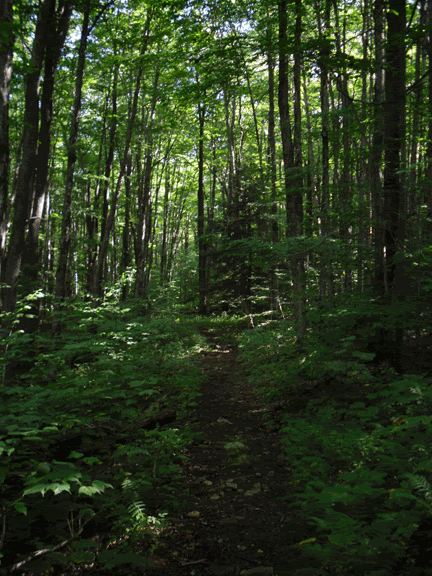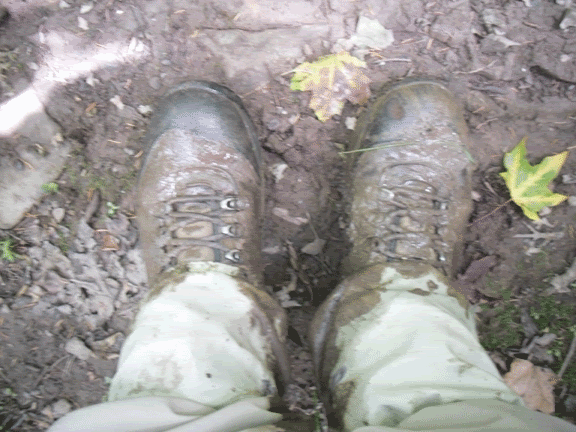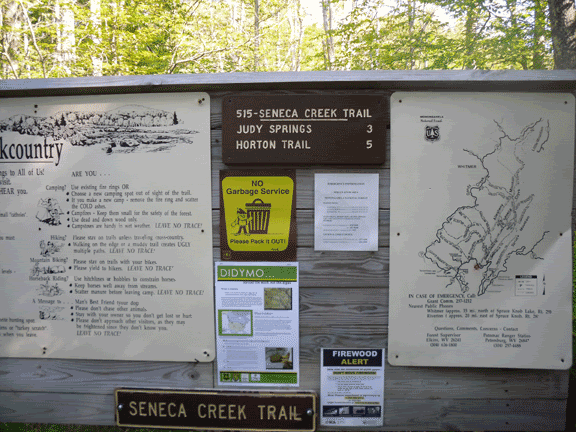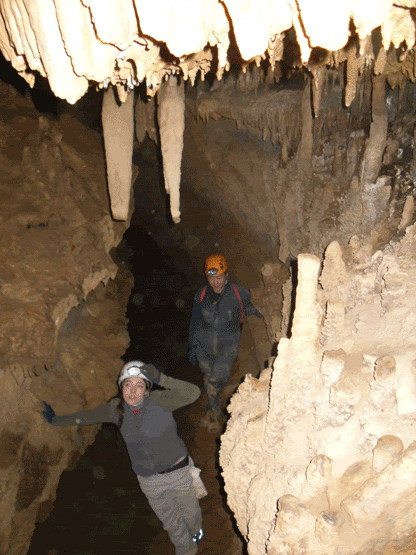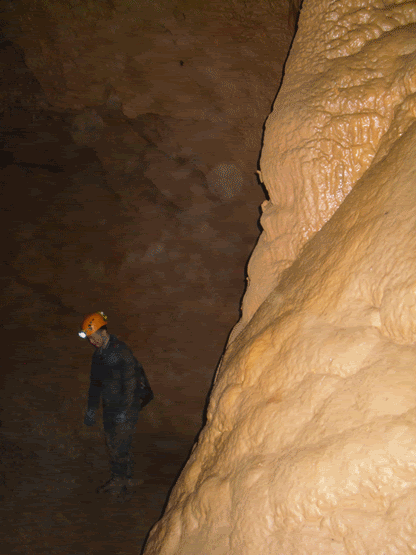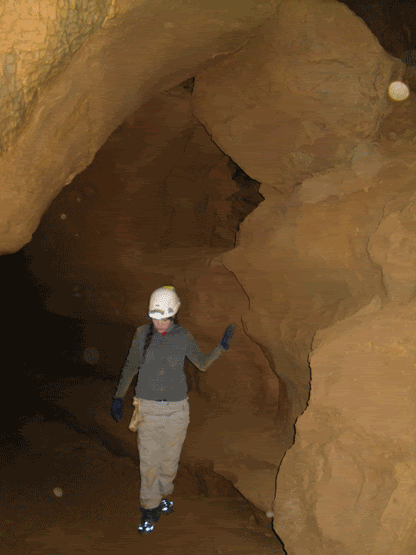Funny how when one reaches the end of the trail it happens unexpectedly, after climbing slowly out of the narrow canyon carved by the Seneca Creek, I saw the gentle left bearing curve and a clearing ahead, hoping that it was nothing more than another one of the numerous meadows along the path…until I spotted my car sitting bluely in the small parking area at the head of the Seneca Creek Trail finally signaling the end of three days in the Wilderness of the Monongahela National Forest in northern Pendleton County, West Virginia.
This was a trip at least a year in the making, definitely before my Shiba Inu pup, my only companion on the trail for three days, was a glimmer in her breeder’s eye, and what else would have first lead me to even pondering this trip except the lure of three caves that are likely the most remote known caves in the county. After reading the descriptions over and over again, and then purchasing the USGS topo maps, I had a general sense of where the real prize possibly lay, High Meadows Cave discovered less than a decade earlier with the remote, no pun intended, possibility of having yet to be explored passage. I decided that this trip was a must. Little did I realize that I was to stumble upon one the West Virginia’s best kept secrets when I began my first few steps down the soggy Lumberjack Trail.
The Bug-lette, flying as co-pilot, and I began our trip to West Virginia two days before hitting the trail with a brief overnight in Harrisburg East Campground (which I will stop short of recommending to anyone, granted it was quiet and cheap (the main criteria), but would I want to stay there again, no. The following day we arrived at Thompson’s Motel (you may recall the motel from the previous caving trip to the nearby Site’s Cave), friendly to not only cavers but backpackers and fortunately dogs as well. My parents made the three hour trip over the mountain to come and visit before I lost my last chance for a shower and general cleanliness for a while.

As a brief detour, I decided to take a drive past our eventual destination, and take a warm-up hike part way up Seneca Rocks, the iconic twin-sandstone slabs beloved by rock climbers. A lot had changed in the past fifteen years since I had visited Seneca Rocks. First of all the Visitor’s Centre had burnt down, and had now been replaced with an expanded one, and the original trail system that one took to the foot of the talus slope had now been replaced by a series of bridges and suspended walks as an archaeological site had recently been discovered there.
We also stopped at one of my favourite places to go caving, Kee Cave, now closed due to White Nose Syndrome, a fungal disease that is affecting the northeastern bat populations. While hiking to the cave, Nori started chasing something that I later rescued and discovered as a cave cricket. Normally it is not recommended to handle them since they are a cave animal therefore very fragile, however I decided that when faced with impending doom at the hands of my dog that some human intervention was acceptable.
We left Thompson’s early the next morning after catching breakfast at the restaurant, and made our way across the low foothills the separate Germany Valley from the rest of Pendleton County, and found our turn off into Forest Service Road 112. The fog lay thick and heavy in the mixed spruce and hemlock forest until the forest road broke through the trees to the first overlook. An ocean of cloud beneath the clearest blue stretching further than the eye could ever hope to see.

The Lumberjack Trail begins its slow ascent on the south-eastern rim of the Seneca Creek Canyon. It is an old railroad grade that was used back when the area was being logged, but now has been converted into a hiking trail. The benefit to starting in this direction is that the trail is an even and relatively easy upgrade (according to the trail descriptions that you read); however do not think that it is easy. Boulders the size of grape fruits are poised to trip you and very often you are slogging through ankle deep mud, but all in all it is a pleasant hike.
Eventually you cross the Huckleberry Trail, and if you stop to look at the trail map one quickly come to the conclusion that the people who printed these trail maps, including the USGS, don’t have a clue as to the correct name and order of the trails. However I knew that my eventual destination for the first day lay in the highest of a string of remote open meadows that I had read about in several descriptions of the exploration of High Meadows Cave and also other hikers who had been through the area.
Five hours after we began from the trailhead we reached our final destination of the day, the first of the high meadows on the southern rim of Seneca Creek, which was somewhere in the thickness of the trees below. After quite a bit of walking around (which according to the Milling About Theory of Speleogenesis, must have created quite a sizeable cave somewhere below us), we finally set up camp, hoisted the food up into the trees above the reach of the omnipresent black bears which had been terrorizing hikers on nearby Dolly Sods and then set out to find a source of fresh water.
This area of West Virginia had been suffering from a drought for a while as I was peripherally aware, but it hadn’t quite registered at the time that we set off for what appeared to be a tributary of Seneca Creek once you reached the second meadow. I was also not quite prepared for the steepness of the descent as the faint trail seemed to take a near vertical descent down the mountain (much fun for Nori with her four-wheel drive, but as for the biped whose every fibre was screaming at it to sit down and stop moving, it was not quite as much fun). Upon reaching the tributary that we had spotted on the map and NOT finding water (if we had gone fifty feet further we would have I discovered on the next day), we began the agonizing ascent back to camp. We after all had enough water for canine and human alike to get us through until the next day which we planned to spend the second night at the established campsite at Seneca Falls.
Sitting and watching the immensity of the sky turn from its milky blue to sapphire, and the long reaching rays of a failing sun while surrounded by the insect symphony and the occasional chirp of bedding birds and the mist rising up from the Seneca somewhere below like an eerie film…this will now forever be my vision of Eden. The constellations one by one crept through the fibre of nightfall, and when I finally expire, this is where I want my ashes spread in the infinity of it all. If there is a divine being, it has left its finger-print here where only time passes.
The next morning, the rising sun casting long shadows along the rim of the Seneca canyon woke us up with the choir of morning song-birds, and after boiling up just enough water to get us through breakfast, I broke camp with the moral support of Nori. We left our perch of the highest meadow to descend into the mute light of the forest and Seneca Creek.
One by one, we passed through each meadow (as well as discovering the tributary to the Seneca that I was hoping would be a water source. It was after one of these meadows that I remembered that High Meadows Cave was nearby, supposedly the most remote cave in West Virginia, and finding the small stream, hitched Nori to a nearby tree and followed it down. I tool a nasty spill on a slick piece of limestone, found the little waterfall near the entrance and turned to find a non-descript crack under a boulder. There was no airflow, but after a little more poking around in the area, determined that this was it. There wasn’t any water flowing out of the entrance, indicating that there was a serious drought going on in the area. I didn’t enter the cave as it would break several of the cardinal rules of caving…never enter a cave alone, wear a helmet and always carry three sources of light.
I marked its GPS location (sorry, I will not share. I’m not being stingy, but it is very remote, hardly anyone travels this way so if you were to get into trouble it may take weeks to recover your body…hiking here is one thing, but to go caving here is something different entirely), and continued on my way to the next trail junction. Here is where my maps, compass and general sense of where I was heading failed me. This trail junction heads in two different directions, one goes uphill and the other leads northeast. Logic would dictate that the downhill direction would be the one to eventually lead you to the bottom of the gorge and to the river, but the arrow was pointing me the other direction, so I turned southwest and started the long trudge uphill.
The original plan was to stop the second day at the established campsite at the impressive Seneca Falls, build a fire and relax to the sound of biomass conversion from the fire pit and the babble of the river, but after two hours of continuing to trudge uphill I began to have my doubts that my goal was within reach. After a quick gander at the GPS (I am cheap, I don’t have the Garmin that displays the map) to get my elevation and some study of the topo map, I realized that I was heading right for Judy Spring, the largest sizable established campsite on the trail, and that I had left Seneca Falls behind. Running low on water, “Noodles” (Nori) and I couldn’t afford to backtrack, so on we went until we reached the open sunny campsite of Judy Spring.
Fortunately for us, the site lived up to its name. Not far from the nearest site, a trail lead off to a tributary of Seneca Creek, and at an impressive headwall, a stream comes gurgling out of a solutional crevice (again, indicating that there is a cave somewhere under the hillside. After amusing myself with trying to climb into the opening where the water rushes forth (and that water is COLD), I refilled our bottles and we returned to our site to set up camp, roll up the pant legs and enjoy the lazy afternoon.
At some point in the morning I woke to a noise outside of the tent. It was close. A sort of scratching sound through the tall grasses, and then I heard it actually rub up against the nylon wall of the tent. Nori was all balled up, shivering. I unzipped my sleeping bag and pulled her inside. It was, after all, around 41° F. She took in a deep breath and then sighed, and fell back asleep. I figured that if she wasn’t too concerned about the sound of whatever critter it was crawling around outside of the tent, then I shouldn’t either and I drifted back off to deep sleep to the melody of the Seneca, babbling away in the dark.
The morning fell heavy, leaving a veneer of dew on everything. The birds were hailing the rise of the sun as I rose and cooked breakfast. After a few more moments of waking up, I packed up camp for the last time, hoisted my pack onto my aching shoulders, hitched up Nori to my waist belt, and off we went, crossing the wooden foot bridge over the Seneca and started the slow ascent to the end of the trail.
The end came abruptly, rudely interrupting the joy of walking. It started as a bright clearing ahead on the footpath, and then I saw the sullen hulk of my car, waiting like a dog that waits for the return of its partner. We had reached the end.
Returning to civilization, I decided to take us on a brief detour to the bald head of Spruce Knob; the last time I had been here was in January nearly twenty years ago with a friend from Junior High School. We had reached the summit of the highest point in West Virginia.
The Seneca Creek – Lumberjack Trail – Highmeadows Trail loop is in the Monongahela National Forest, and contains some of the most remote areas of Pendleton County. For more information, visit the Monongahela National Forest website. When travelling through the back-country, please follow all rules regarding campfires and follow the best practices of hiking in remote wilderness. Always tell someone where you are going and when you plan to return. Wear appropriate footwear and clothing. At these elevations the weather can be unpredictable, so come prepared to be dressed in layers and bring waterproof clothing, and take in the infinity of it all.





